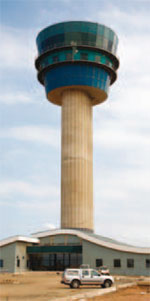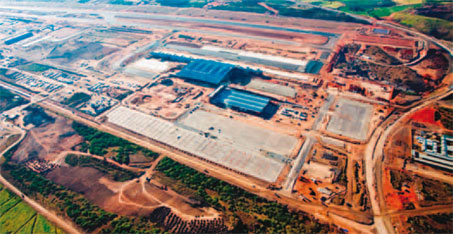
ACSA has invested R17 billion (€1.68 billion) in South Africa’s airport infrastructure, with R6.8 billion (€670 million) spent on the new King Shaka International Airport.
Since the start of the major development project in 2006, ACSA has invested billions of Rand in expanding and upgrading facilities across its network of airports in preparation for the arrival of as many as 450,000 visitors during the course of the World Cup. While development of the so-called ‘golden triangle routes’ – Johannesburg, Cape Town and Durban – has been a key factor, major construction work has also been ongoing at numerous other airports including Bloemfontein, Port Elizabeth, East London, Kimberley and Upington airports.
“In 2006, we embarked on this programme, which would generally improve capacity and service offerings at the airports in our network,” said Hlahla. “These improvements fortuitously coincided with our country being awarded the hosting rights for the 2010 FIFA World Cup finals tournament and by the end of this financial year in March, Airports Company South Africa will have invested about R17 billion (€1.68 billion).”
Golden triangle routes
O.R. Tambo International Airport (ORTIA) – which serves Johannesburg and handles in excess of 17 million annual passengers – has undergone a R3 billion (€297 million) overhaul as part of the project. While the influx of football fans is one reason behind the development, plans to improve and expand the airport were already in place before the country was chosen to host the World Cup with ACSA keen for ORTIA to cater for ever-increasing passenger numbers and new-generation aircraft.

Cape Town International Airport will boast a common use central terminal, improved F&B facilities and a new 4,000 bay multi-storey car park upon completion of the development project in April.
The construction of a new Central Terminal Building, which is connected to the Gautrain Rapid Rail Link for easy access to Johannesburg, Sandton and Pretoria, provides the centrepiece of the redevelopment, while an upgrade to the Terminal A departures and a new multi-storey car park are also well underway. A new Echo Apron, with nine new aircraft stands, and the R533 million (€52.7 million) international pier have already been completed.
Hlahla said: “We have just completed the Central Terminal Building which is the final building block in a complete redevelopment of the terminal precinct that was commenced more than 10 years ago. The project finally brings together all the domestic and international terminals and creates one contiguous space, which greatly improves the passenger experience and orientation.
“This flagship of O.R. Tambo International Airport is complemented with recently completed pier and apron developments that allow us to accommodate new generation large aircraft. In fact, Air France- KLM commenced scheduled operations of the new super jumbo, the A380, in February.
“The Central Terminal Building is designed to give passengers a smooth and uninterrupted travel experience by facilitating processing through the various check-in and departure procedures, transfer and the like, all in the same terminal building, which is a first for this flagship airport.”

The brand new King Shaka International Airport is located 30km north of Durban city centre and is scheduled to open for operations on 1 May.
Another airport serving one of the golden triangle routes, Cape Town International Airport, has also undergone a complete transformation. “By April this year, the redeveloped airport will boast a common use central terminal with vastly improved retail and food and beverage facilities, as well as a second 4,000 bay multi-storey parkade and the road network upgrade,” explained Hlahla. “Also, a first for this airport is the introduction of an elevated drop-off kerb, which allows passengers to access the check-in hall with greatly improved ease and protection from the elements.”
King Shaka International Airport
To complete the regeneration of the country’s three busiest routes, Durban has seen the most significant transformation with the construction of a brand new airport to replace the existing Durban International. Located approximately 30km north of Durban’s city centre, the new R6.8 billion (€670 million) King Shaka International Airport is scheduled to open on 1 May.
While it will boast an initial capacity of 7.5 million annual passengers, future expansion has also been taken into account and by the year 2060, there is scope to increase this number to as many as 45 million. Thanks to its 3.7km runway and large terminals, Durban’s new airport will be able to handle the A380 and it also includes a state-of-the-art cargo terminal. In addition, when complete, King Shaka International Airport will also boast separate arrivals and departures terminals on different levels, a separate baggage terminal, air bridges, parking for 6,500 vehicles and the status as the first greenfield airport in the country.

Hlahla: “This is a huge marketing opportunity for the country and we want the soccer fans to come back after the World Cup as tourists or for business purposes.”
Smaller airports

Johannesburg’s Soccer City, which will host the opening game and the final of the World Cup, will be served by South Africa’s busiest airport – O.R. Tambo International.
In order to accommodate both the sharp increase of World Cup-related traffic in June and July and the long-term increase in overall passenger numbers, various other airports across South Africa have also been included in the major improvement programme. “The smaller airports in our stable are not neglected,” Hlahla explained. “In fact, we see them as an integral part of the overall aviation network. Many of them will also have to play a significant role during the 2010 FIFA World Cup.”
Among the smaller airports that have benefited from the investment is Bloemfontein International Airport, which has undergone a runway renovation and a complete terminal refurbishment at a total cost of R170 million (€16.8 million). During the course of the month-long tournament, temporary facilities will also be erected to enable the airport to cope with additional international visitors. Similarly, ACSA has already completed the runway refurbishment project at Port Elizabeth Airport at a cost of R86 million (€8.5 million).
At East London Airport, a significant project involving an upgrade of the terminal building will see the addition of five new check-in counters, a new security check-in point, two new departure gates and the expansion of the departure lounge area to 529sqm. Along with the terminal expansions at Kimberley and Upington airports, the project is scheduled to be complete by the end of April.
Unique event
While South Africa has previously hosted global sporting events – most notably the Rugby World Cup in 1995 and the Cricket World Cup in 2003 – Hlahla believes that the 2010 FIFA World Cup poses a more unique and complex challenge.
She said: “We have hosted many major events in the past. The World Cup is, however, unique in terms of expected passenger traffic. For the airports to be operationally ready, certain information is required from the organisers. Key was the draw on 4 December last year to determine which teams will face each other where, then the team base camp confirmation followed.

As many as 450,000 visitors are expected to embark on South Africa during the course of the month-long World Cup, which kicks off on 11 June.
“Armed with this information, we now have a good understanding regarding the flow of passengers between the matches and where the majority of the supporters are going to be based. What is very clear is that O.R. Tambo International Airport will be a key entry point into the country and the golden triangle routes will be the busiest throughout the tournament.”
While the vast majority of the work is complete, preparations will still be ongoing right up until the start of the tournament. “To complete the operational plan, finalisation of ticket sales indicating the volume of international spectator purchases, confirmation of accommodation by spectator groups and airline slot uptake for the period of the 2010 FIFA World Cup are still required,” Hlahla said.
Long-term investment
On 2 March, at a conference to mark the beginning of the 100-day countdown to the start of the World Cup, FIFA announced that 2.2 million of the 2.9 million tickets have already been sold, confirming expectations of a huge turnout during the course of the tournament. Sepp Blatter, President of FIFA, also outlined that he has “no doubt” that South Africa is ready to host the most watched sporting event in the world.
However, while ACSA’s widespread airport improvement and expansion project is vital to South Africa’s hosting of the World Cup in the summer, the investment in airports around the country is about more than just a four-week period and a global sporting event. With an unprecedented number of major construction developments either complete or nearing conclusion, ACSA, and the South African nation as a whole, is holding its head high, safe in the knowledge that the World Cup is only the beginning of this major transformation.
“I am very proud and pleased to have been part of ensuring that South Africa hosts a successful event,” said Hlahla. “This is a huge marketing opportunity for the country and we want the soccer fans to come back after the World Cup as tourists or for business purposes. We are particularly proud of just about completing our most ambitious capacity development programme ever.”







